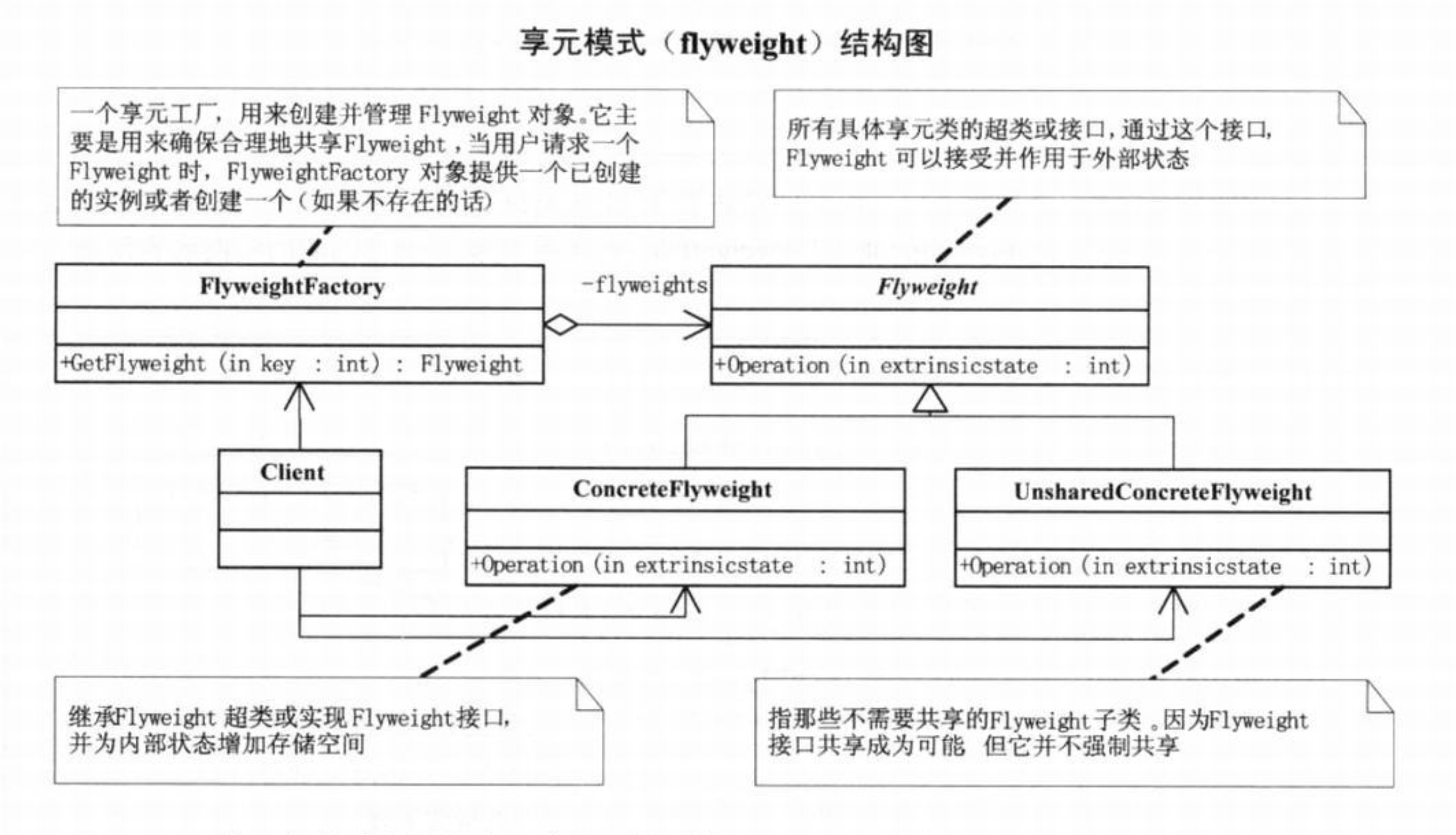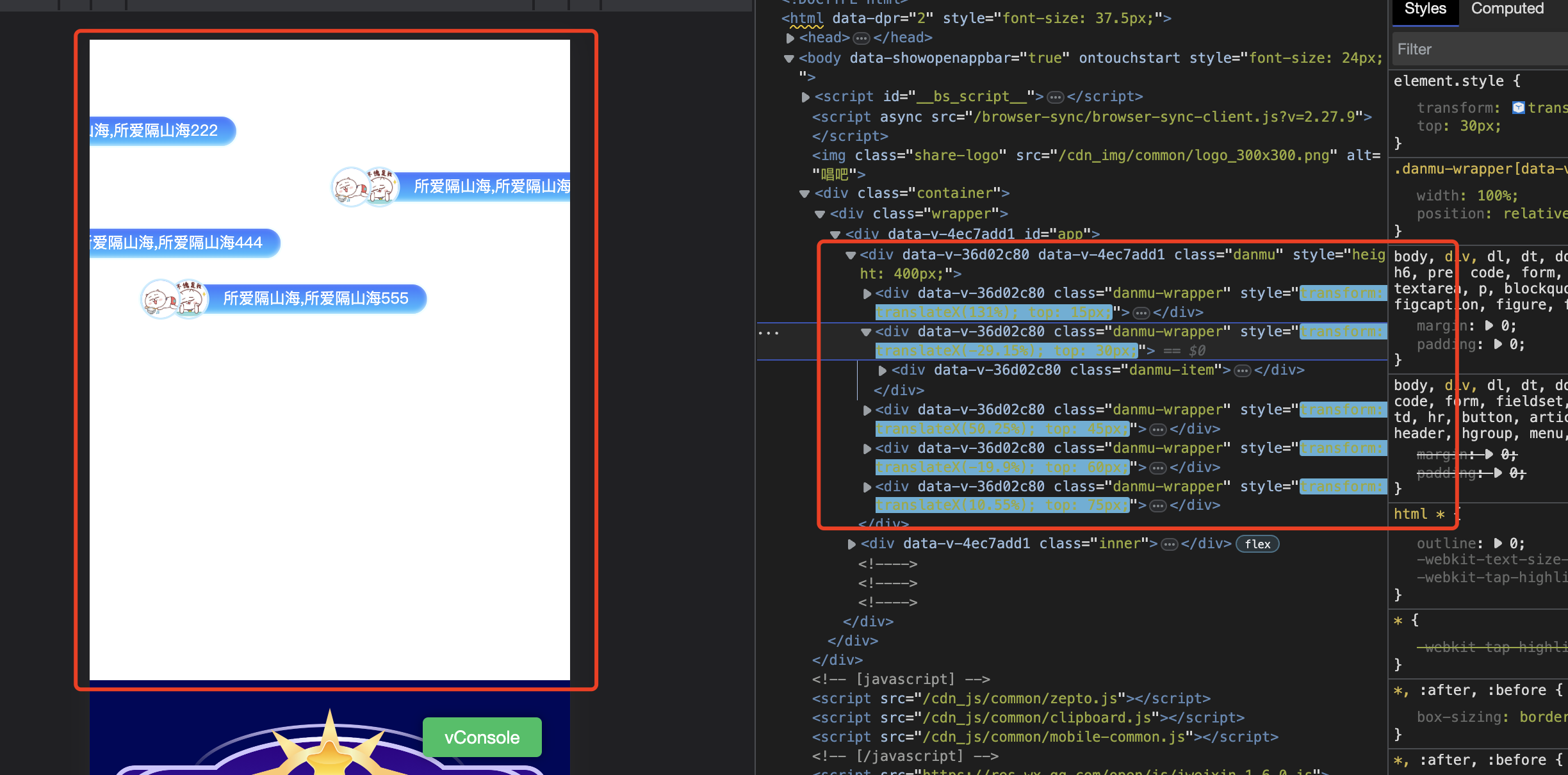# 享元模式
# 1、基本概念
享元模式,是一种用于性能优化的设计模式,享元模式的英文叫fly-weight,其含义是蝇量级,主要用于减少创建对象的数量,以减少内存占用和提高性能。
享元模式的关键是划分内部和外部状态(变化和不变,不变的就是复用对象的内部状态,变化的内容则由外界传递进来,在某一刻得到执行(有点儿依赖注入:Dependencies Inject,简称DI的味道))来实现对象的复用的,另外,享元模式会有工厂模式的思想在其中,工厂实现对象的复用逻辑的控制。
我将其字面意思理解成”共享-元数据“(仅仅是我个人的理解,非官方解释,因为享元模式需要划分内部和外部的状态,内部的状态数据不就是复用对象的元数据嘛,而外部的数据是根据需求传递的,内部数据不就成了共享的嘛,哈哈哈)。
以下是享元模式的UML图:

上图的含义是,FlyWeight抽象了一个功能,通过ConcreteFlyWeight和UnsharedConcreteFlyWeight去实现它,同时定义了一个享元工厂,FlyWeightFactory,其对外暴露一个获取FlyWeight对象实例的方法,当我们需用用到ConcreteFlyWeight的实例时,从FlyWeightFactory取,如果去不到,则初始化,并将其存储起来,如果已经初始化,则直接复用。
# 2、代码示例
abstract class FlyWeight {
abstract notify(msg: string): void;
}
class ConcreteFlyWeight extends FlyWeight {
notify(msg: string): void {
console.log("我是享元对象输出消息:" + msg);
}
}
class UnsharedConcreteFlyWeight extends FlyWeight {
notify(msg: string): void {
console.log("我是非享元对象输出消息:" + msg);
}
}
class FlyWeightFactory {
private static map: Map<string, FlyWeight> = new Map();
static {
// 系统初始化一些干活儿的对象
this.map.set("A", new ConcreteFlyWeight());
this.map.set("B", new ConcreteFlyWeight());
}
static getFlyWeight(type: string): FlyWeight {
// 如果对象不存在,则创建,如果存在,直接复用对象
let flyWeightInstance = this.map.get(type);
if (!flyWeightInstance) {
flyWeightInstance = new ConcreteFlyWeight();
this.map.set(type, flyWeightInstance);
}
return flyWeightInstance;
}
}
function bootstrap() {
const flyA = FlyWeightFactory.getFlyWeight("A");
const flyB = FlyWeightFactory.getFlyWeight("B");
const flyC = FlyWeightFactory.getFlyWeight("C");
const flyD = FlyWeightFactory.getFlyWeight("A");
const normalObj = new UnsharedConcreteFlyWeight();
flyA.notify("你好,比尔盖茨~");
flyB.notify("你好,库克~");
flyC.notify("你好,乔布斯~");
flyD.notify("你好,马云~");
normalObj.notify("你好,雷军~");
}
# 3、前端开发中的实践
由于现代Web前端开发一般都会基于Vue,React等基于虚拟DOM的框架进行开发,再加上ESM语法的出现,享元模式的在实际的业务开发场景不常见。
像一些设计模式书上给出的例子,可能某些时候基于框架开发,就完全不会那样去写代码了,设计模式是为了降低我们代码的复杂度,增加软件的可维护性,所以不要为了设计模式而设计模式。
比如曾探先生所著的《JavaScript设计模式与开发实际》一书中,对于享元模式给的示例是一个文件上传的例子,但是如果基于Vue或者React框架编写代码,可能就直接让文件上传这个功能模块成为一个组件了(可以用虚拟滚动来处理上传文件的列表项过多;可以用一个任务管理器控制并发以防止一下并发过大,造成浏览器卡死,这个场景会限制并发,但也不是套用享元模式的代码范式)。
以下是一个我最近在一个实际开发中出现的例子,这个场景就是一个十分恰当的例子。
它是一个弹幕组件,系统需要支持有5000条弹幕推送,如果这5000条数据完全交给框架处理的话,将会建立超多的双向绑定(以Vue框架为例),此时肯定性能上是达不到要求的,另外,也不可能一下子把5000条数据一下渲染出来,否则就没法看了。
同时,这些消息还有优先级,比如如果是付费用户的消息,它的优先级要求比普通用户优先展示,直接一下子渲染出来,这个逻辑也不太好写。
根据享元模式的思想启发,实际上我们可以创造一定的弹幕内容节点(搬运工),首先为它准备好它要展示的内容(外部状态),然后事先让两者进行绑定,让它从屏幕的右边滚动到左边,然后它可以再回到右边,解绑。然后重新为它绑定新的弹幕信息展示,重复这个过程,直到把所有的消息都展示完毕。这样就可以使得我们在有限的DOM上展示很多的信息,同时,处理消息的优先级就变成了处理队列或者处理堆了,也将核心业务逻辑解放了出来。
下图是我编写的组件的运行效果:

以下是上述逻辑的vue编码实现。
<template>
<div class="danmu">
<!-- 只渲染有限的DOM节点,进行数据的展示 -->
<div
class="danmu-wrapper"
v-for="(ctx, idx) in worker"
:key="idx"
:style="{
transform: `translateX(${worker[idx].offset}%)`,
top: `${20 * idx}px`,
}"
>
<div class="danmu-item">
<template v-if="ctx.body">
<div class="danmu-user">
<div class="danmu-user__wrapper u1">
<img
class="danmu-user__wrapper-img"
:src="ctx.body.user1.avatar"
alt="用户头像"
/>
</div>
<div class="danmu-user__wrapper u2">
<img
class="danmu-user__wrapper-img"
:src="ctx.body.user2.avatar"
alt="用户头像"
/>
</div>
</div>
<p class="danmu-body">{{ ctx.body.message }}</p>
</template>
</div>
</div>
</div>
</template>
<script>
export default {
name: "Danmu",
data() {
return {
initPosition: [140, 100, 120, 170, 110],
// 用来从右到左负责搬运弹幕的工人们
worker: [
{
offset: 0,
body: null,
},
{
offset: 0,
body: null,
},
{
offset: 0,
body: null,
},
{
offset: 0,
body: null,
},
{
offset: 0,
body: null,
},
],
// 用来记录消息过多时,还没有播放的弹幕信息
taskQueue: [],
// 用来记录消息是否是优先级较高的
map: new WeakMap(),
};
},
mounted() {
// 在组件渲染后,开始搬运弹幕信息
this.start();
},
methods: {
addTask(task, emergency) {
const available = this.worker.filter((v) => v.body === null);
// 随机取一个能用的工人
const worker = available[Math.floor(Math.random() * available.length)];
// 暂时没有可用的搬运工人,加入等待队列
if (!worker) {
console.log("请稍后,暂时没有工人能够干活啦");
if (emergency) {
// 找到第一个紧急任务,因为紧急任务也有先来后到的优先级,紧急任务不能直接插入到待处理消息队列的头部
let idx = 0;
let existTask = this.taskQueue[idx];
while (existTask && this.map.get(existTask)) {
existTask = this.taskQueue[idx];
idx++;
}
// 将当前任务标记为紧急任务
this.map.set(task, true);
// 如果当前任务队列里面没有紧急任务,可以直接插入任务
if (idx === 0) {
this.taskQueue.unshift(task);
} else {
// 否则,插在紧急任务之后,idx是第一个非紧急任务的下标
this.taskQueue.splice(idx - 1, 0, task);
}
} else {
// 非紧急任务,可以直接放在临时消息队列的尾部
this.taskQueue.push(task);
}
} else {
// 为当前工人绑定它需要搬运的信息
worker.body = task;
// 重新开启动画
this.startMove(this.worker.findIndex((v) => v === worker));
}
},
start() {
// 初始化开启搬运弹幕
let idx = 0;
this.worker.forEach(() => {
this.worker[idx].offset = this.initPosition[idx];
this.startMove(idx);
idx++;
});
},
startMove(target) {
// 如果当前搬运工没有任务需要处理,则不需要后续的流程
if (!this.worker[target].body) {
return;
}
// 如果当前搬运工已经将弹幕搬运到了最左边
if (this.worker[target].offset <= -100) {
this.worker[target].offset = this.initPosition[target];
// 卸载当前搬运的内容
this.worker[target].body = null;
// 如果已经没有资源了,结束当前搬运工的任务
if (this.taskQueue.length <= 0) {
return;
}
// 如果已经处理完成了一个内容,发现消息队列里面还有内容,继续搬运
if (this.taskQueue.length) {
const task = this.taskQueue.shift();
this.worker[target].body = task;
}
}
requestAnimationFrame(() => {
// 动画处理
this.worker[target].offset = (
this.worker[target].offset - 0.45
).toFixed(2);
this.startMove(target);
});
},
},
};
</script>
<style lang="scss" scoped>
.danmu {
width: 100%;
height: 500px;
&-wrapper {
width: 100%;
position: relative;
}
&-item {
max-width: 100%;
height: 52px;
background-image: linear-gradient(180deg, #3b73ff 0%, #2fc7ff 100%);
box-shadow: inset 0 -2px 7px 0 rgba(255, 255, 255, 0.71);
border-radius: 30px;
border: 4px solid azure;
font-size: 24px;
font-family: PingFangSC-Regular, PingFang SC;
font-weight: 400;
color: #ffffff;
display: inline-block;
text-align: right;
line-height: 44px;
padding-right: 28px;
padding-left: 130px;
position: relative;
}
&-body {
max-width: 360px;
white-space: nowrap;
overflow-x: hidden;
text-overflow: ellipsis;
}
&-user {
position: absolute;
left: 0;
display: flex;
align-items: center;
top: 50%;
transform: translateY(-50%);
&__wrapper {
width: 64px;
height: 64px;
background: linear-gradient(180deg, #1558fc 0%, #3bb1ff 100%);
box-shadow: inset 0 -2px 7px 0 rgba(255, 255, 255, 0.71);
border: 4px solid rgba(198, 237, 255, 1);
border-radius: 50%;
position: relative;
&-img {
width: 100%;
height: 100%;
border-radius: 50%;
}
}
.u1 {
z-index: 2;
}
.u2 {
transform: translateX(-20px);
z-index: 1;
}
}
}
</style>
在这个实践中,弹幕信息节点的位置信息就是它的内部状态,弹幕信息节点展示的内容就是它的外部状态。
另外,在这个例子中,任务的优先级只有两个判别依据,所以我们可以简单的用一个WeakMap(是用WeakMap的优势是不用关系消息对象什么时候销毁)来标记,假设您的业务需求可能有好几种优先级判别依据,那么你就只能用堆来解决这个问题了(比如医院急诊科医生处理任务,一个病人已经休克,一个病人的伤口血流不止,一个病人发着高烧,另外一个病人只是感冒了,那么医生肯定会病情的轻重缓急决定先救治哪个病人)。